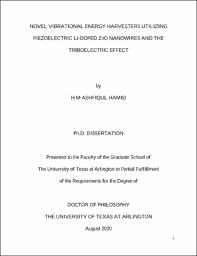| dc.description.abstract | Vibration sources are omnipresent everywhere in our regular lives including the automobiles, aircraft, human body motion, wind flow, and water waves. Vibrational energy harvesters are electromechanical systems that can convert the ambient vibrations into electrical energy which can be stored to power up small scale electronic devices, essentially converting them into self-powered systems. The electronics industry has always propelled towards the scaling of electronic devices for improved flexibility and reduced production cost. This scaling, combined with the power-efficient designs, is widening the scope of applications for the energy harvesters. For instance, the vibrational energy harvesters have substantial applications in small scale sensor nodes, wearable electronics, robotics and prosthetics systems, mobile and implantable medical devices as well as in many other electronic systems.
This dissertation presents the design, fabrication, and characterization of two such vibrational energy harvesting systems: the first one being a piezoelectric energy harvesting system based on Li-doped ZnO nanowires (NWs); and the second one being a microelectromechanical systems (MEMS) scale triboelectric energy harvesting system with high operating frequency and wide frequency bandwidth.
A complete investigation of the effect of Li doping on the physical, material, electromechanical, and piezoelectric properties of ZnO NWs is presented in the first project. Low-temperature hydrothermal growth technique is used to grow vertically aligned crystalline ZnO NWs doped with different concentrations of Li. Characterization techniques reveal considerable physical, material, and electromechanical property modifications of the ZnO NWs due to the incorporation of Li dopants. Atomic Force Microscope (AFM) is utilized to apply a controlled amount of force on the fabricated NWs to assess their piezoelectric response. More than twenty two-fold improvement is observed in the sensitivity due to the combined effect of modifications in NW geometry and piezoelectric properties with the addition of Li. Finite element method simulations were performed to decouple the individual effect of Li doping on the NW size and on the piezoelectric coefficient as well as to see how much each effect plays a role in the sensitivity improvement. It is estimated that the changes in the material and electromechanical properties alone are responsible for more than seven-fold improvement in the sensitivity. The impact of the ‘kick-out’ diffusion mechanism of Li in ZnO is one of the major factors responsible behind this sensitivity improvement. It is also observed that there is an optimum level of Li doping concentration which can lead to the best piezoelectric performance by the ZnO NWs. The novelty of this work lies in the detailed analyses to illustrate the physics and impact of Li dopants in ZnO NW structures from a piezoelectric point of view towards improving their application as a nano-sensing and nano-energy harvesting element.
For the second project, a novel triboelectric energy harvesting (TEH) and sensing system scaled down to MEMS size is presented. The design is structurally optimized for harvesting the highest average power and power density while ensuring the structural robustness. Unlike traditional triboelectric energy harvesters, this design results in a high operating frequency with a wide bandwidth. Adoption of MEMS fabrication techniques including the use of spin-coated Teflon AF rather than a Teflon sheet, adaptation of UV-LIGA (Ultra-Violet Lithographie, Galvanoformung, Abformung) with modifications and implementation of a thick polyimide sacrificial layer make the fabrication process unique. If excited by 9.33g external vibration with a frequency of 1150 Hz, the TEH can generate 0.179 uW average power and 0.597 uW peak power at an optimum resistive load of 256 kohm. The peak surface power density, volumetric power density and acceleration-normalized volumetric power density reach 3.98 uWcm-2, 2.64 mWcm-3 and 30.3 uWcm-3/g2, respectively. While the surface power density of the presented TEH is moderate, the volumetric power density and acceleration-normalized volumetric power density are quite competitive among the state-of-the-art designs. The TEH also demonstrates a wide operating frequency bandwidth of 920 Hz. If operated as an accelerometer, the device shows a linear sensitivity of 43 mV/g. Although the simulation predicts the optimum operating frequency and load resistance of the system to be at 800 Hz and 10 Mohm, respectively, the experimental results demonstrate these values to be at 1150 Hz and 256 kohm. A few fabrication anomalies, most notably the notching in the Teflon layer and bowing of the proof-mass, are responsible for this deviation. In addition, a distortion is observed in the simulated output voltage profile which is not present in the experimental output voltage profile due to the presence of the parasitic capacitance in the experimental circuit. The aforementioned triboelectric energy harvester can have specific applications in the sensor and actuator systems in the aircraft industry as well as in the automobile industry, micro-robotic systems, prosthetic systems, and sensor nodes in the internet of things (IoT) based on its operating frequency and bandwidth range. | |


